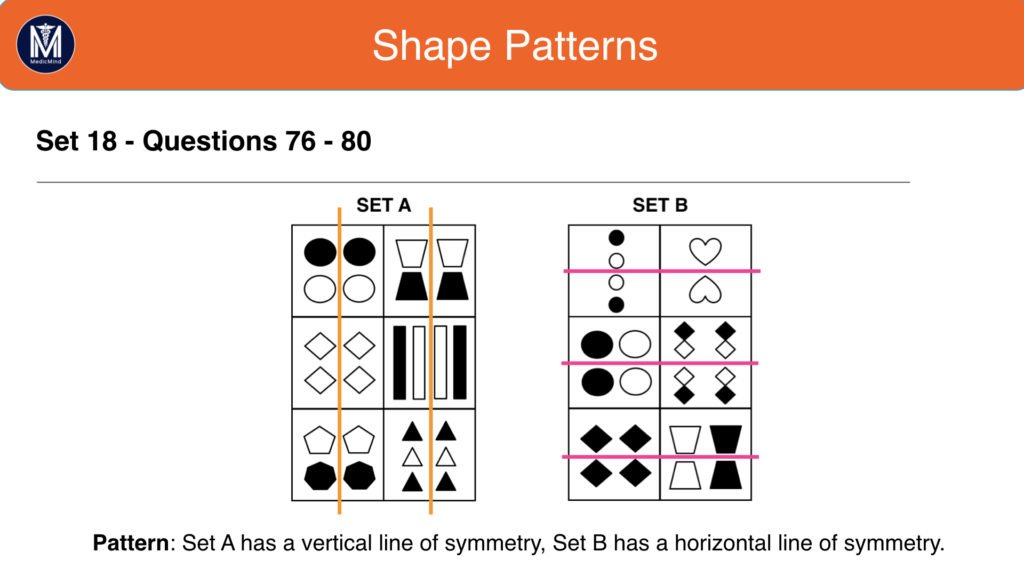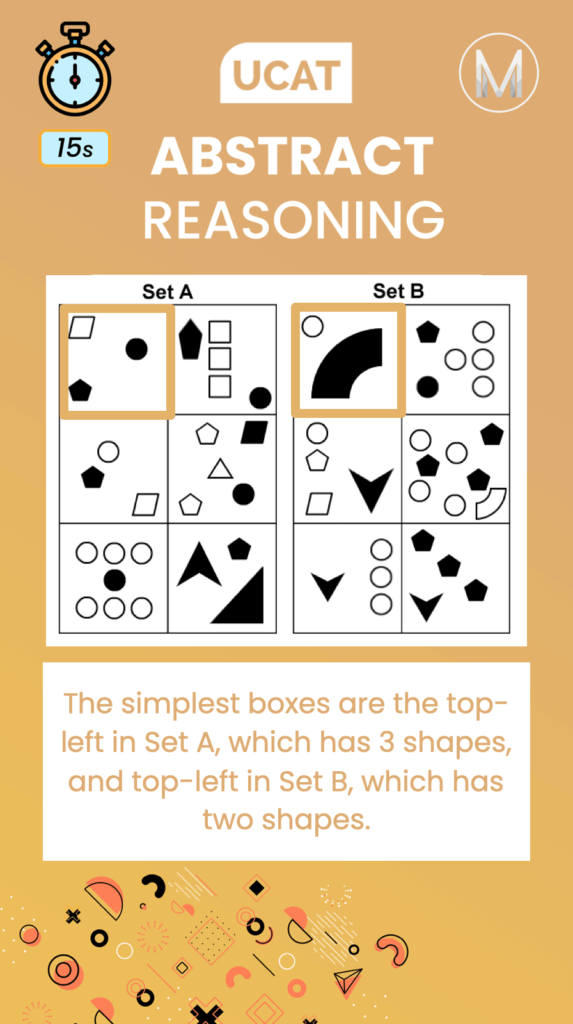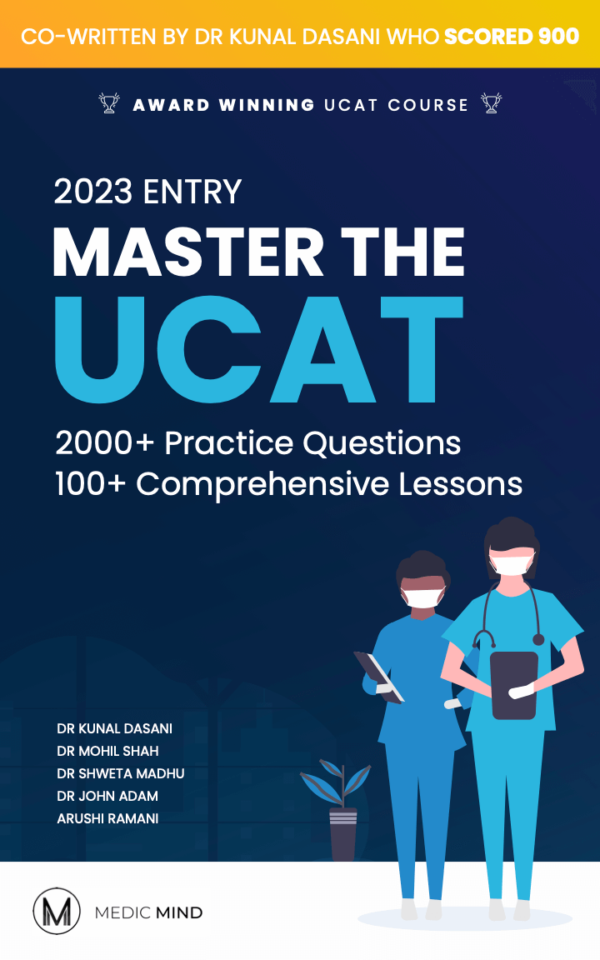Loading...

UCAT Abstract Reasoning: 6 UCAT Tips For Success
Abstract Reasoning has long been thought of as one of the hardest and most frustrating UCAT sections. It has a reputation with students for causing confusion and trick questions eating up a lot of precious time. The section can be intimidating at first, as it can look quite different to traditional exam questions you’ve faced before, but don’t let this put you off!
This section, like all the others can be mastered. All it takes is some well-structured practice and an insight into the structure behind the questions. Remember that no matter how random the question shapes appear, there is always a pattern behind them. All you need to do is find that pattern and use it to answer the other questions. Hopefully by following these six key tips you can start your mastery of the UCAT abstract reasoning section.

1. Use UCAT Abstract Reasoning pattern tables
UCAT Abstract Reasoning tests your ability to recognise patterns in what intially appear to be random arrangements of shapes. When you approach this for the first time it can seem completely incomprehensible. Remember that there is always a pattern, and not only that but, there is ultimately only a finite number of patterns that can exist within the UCAT Abstract Reasoning section.
When you’re preparing you should create a pattern table to list and organise all of the different patterns that you come across. This allows for you to approach each question more systemically and identify the most common patterns.
To begin with this technique may seem laborious but as you begin to memorise the patterns you will be able to speed up. Hopefully over time this will allow you to be move through questions more efficiently and accurately.

There are four different questions types in the UCAT Abstract Reasoning. Knowing these question types well and having set strategies on how to tackle each of them will help in ensuring that you don’t get thrown off by difficult questions. The four question types are:
| Question Type | Example |
| Set A, B or Neither | There are two sets of shapes shown as Set A and Set B. You will be shown additional test shapes and need to decide if they belong to Set A, B or neither. |
| Sequence | Choose the shape that comes next in the sequence based on a sequence of four shapes that change based on a specific pattern. |
| Finish the statement | A question will be displayed with an incomplete statement: Shape A is to Shape B as Shape X is to Shape ? You need to choose the image to complete this statement. |
| Set A or B | There are two sets of shapes shown as Set A and Set B. You will be shown to select a shape that belongs to either Set A or Set B. |
2. Memorise key triggers
As you prepare for this section you will become more familiar with the different types of question in UCAT Abstract Reasoning. You may also start to see that different patterns will have certain things in common. You can use this to your advantage by noticing these shared characteristics quickly, and focusing your attention to certain categories of pattern first. This will help you find the underlying pattern faster.
What I mean by this, for example, is that if you see crescent moons, this should trigger you to start looking for a pattern based around curved and straight shapes. This is because the number of shapes with curved lines is quite small, so if they’re being included it is likely that the curved aspect is central to the pattern.
Another example is if you see lots of overlapping shapes, look for a pattern based on the number of intersections between these shapes.

Once you have begun to recognise triggers you can add these into your pattern table to help remind you of what to look for. This is one of the best tips to help to increase your speed, as from the trigger alone you can already narrow the possible patterns in front of you. Below are a few common patterns that you should keep an eye out for:
- Shape: Look out for a particular shape being repeated within the Set or if all the shapes in a Set share a particular feature e.g even number of sides
- Position: Try to spot if a particular shape is always in a certain place within the box e.g right upper corner or if it’s always placed between two other shapes
- Rotation: Consider if a shape is rotating within a set pattern e.g clockwise
3. Choosing appropriate resources
With UCAT Abstract Reasoning practise and becoming familiar with question types is key. This means that you need to have access to some high-quality resources or books to provide you with good practise material.
It’s important to note that sometimes these practice questions may be harder than those in the actual UCAT itself. For example, the ISC 1250 book is typically reported to be very difficult. It’s useful to bear this mind as while some students may find this good preparation, others may find it overwhelming and off-putting.
If you’re struggling with the resources you have, or UCAT Abstract Reasoning in general, then you may benefit from one of our one-to-one tutors. They will be able to go through our extensive question bank with you, helping you to identify patterns and can tailor the sessions to your exact needs.

4. Abstract Reasoning: Timing Tips
UCAT Abstract Reasoning is the shortest section at just 12 minutes, but it also has the largest number of questions at a whopping 50. It is critical that you know how long (or little!) you have per question and do not lose track of this. If you have not practiced extensively ahead of test day, it is very easy to get caught up on the challenging questions and run out of time.
There are several different question types in this section. You need to adjust how long you spend on each question depending on the type.
For example, Type 1 questions have 1 pattern with 5 associated questions. So here you have a minute to spend on the whole question set. Where as for Type 2 questions you just have 1 pattern and 1 question, giving you 14 seconds per pattern. This means you have to adjust how long you spend looking for the pattern accordingly, so as not to get stuck on these lower yield questions.
| Type 1 Questions |
|---|
| 1 Pattern |
| 5 questions per set |
| 1 minute per pattern |
| Type 2 Questions |
|---|
| 1 Pattern |
| 1 question per set |
| 14 seconds per pattern |
5. Know when to move on
UCAT Abstract Reasoning is a challenging section, and it is easy to get carried away trying to solve tricky questions. In the end some of the patterns are just too hard, and they’ve been designed this way!
Hard questions with very complex intricate patterns are deliberately put into the exam to try and slow students down. Candidates who don’t have the ability to quickly identify a question is beyond their capabilities in the time limit will end up wasting minutes trying to solve the problem. If you find a question like this, put your best guess and move on. Your time will be of better use and yield more marks elsewhere.
Remember the UCAT is not negatively marked so if you’re going to move on there is no harm in guessing. Never leave a question blank on the UCAT, even if it’s a guess as you still have a chance of guessing correctly.
6. Always start with the simplest box
Whenever you get presented with two sets of patterns, you should always look at the box in each set with the fewest number of shapes. This will enable you to properly compare each set and keep you from getting distracted.
The simplest box doesn’t always have to be the one with the fewest shapes. It can also be:
- the box with fewest colour variations e.g. striped, black etc.
- the box with obvious pattern e.g. a very large shape
- the box with repeating units e.g. 4 triangles

Frequently Asked Question
→How long is UCAT Abstract Reasoning?
The Abstract Reasoning section is just 12 minutes long. You have to answer 50 questions in this time, meaning that this is the most time pressured section. It’s best not to get carried away wasting lots of time on the hardest questions as you’ll be better off using that time on easier questions and yielding more marks in the process.
→What is a good UCAT Abstract Reasoning score?
In 2022, the average score for the UCAT Abstract Reasoning section was 659. Anything above this will put you in the top half of candidates who sat the exam. Remember that universities usually look at your UCAT score as a whole so a good performance here can make up for weaker scores in other sections.
→How many questions are there in the UCAT Abstract Reasoning test?
The UCAT Abstract Reasoning test consists of 50 questions, which must be completed within 12 minutes.
→How can I prepare for the UCAT Abstract Reasoning test?
There are several ways to prepare for the UCAT Abstract Reasoning test, including practicing with online resources and mock exams, reviewing study materials and guides, and seeking advice and guidance from peers and professionals.
→How important is the UCAT Abstract Reasoning test for my UCAT score?
The UCAT Abstract Reasoning test is one of the five subtests of the UCAT exam, and it contributes to your overall UCAT score. While the weightage of each subtest varies from one medical school to another, it is important to do your best in all subtests to maximize your chances of getting accepted into a medical school.
→How can I improve my UCAT Abstract Reasoning score?
The best way to improve your UCAT Abstract Reasoning score is to practice regularly and familiarize yourself with the format and types of questions in the test. You can also seek advice and guidance from peers and professionals, and consider enrolling in a UCAT preparation course.
Related
Related Articles
Support for the whole medical application process from UCAS application, UCAT/BMAT, personal statement, interview and more!
With over 1000 UCAT questions, mock paper walkthroughs and timing tips and advice
A unique opportunity to explore the world of healthcare through interactive simulations and real-life case studies. Run by senior physicians
Personalised private lessons, tailored to your UCAT needs





Was this article helpful?
Still got a question? Leave a comment
Leave a comment
366 Comments
AnonymousMedic Mind Tutor
6 June 2022
Is it possible to answer every single question in the UCAT?
Anna CharlotteMedic Mind Tutor
23 July 2022
Nothing is impossible but you’d have to be pretty fast to answer every question. Remember it is still possible to get a VERY good score without answering every single question. It is far better to answer 90% of the questions with full accuracy than to rush yourself and answer all of the questions with lower accuracy.